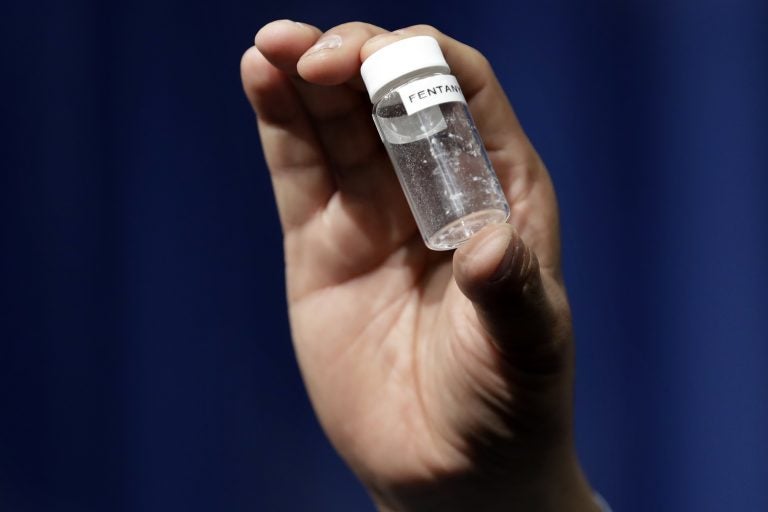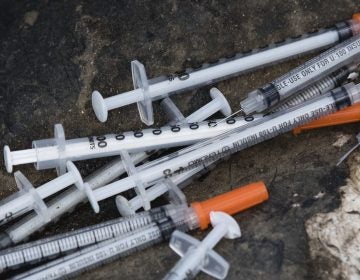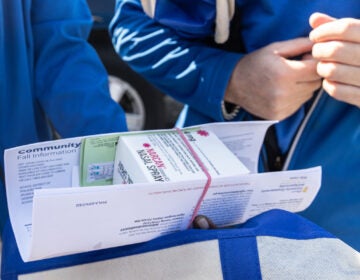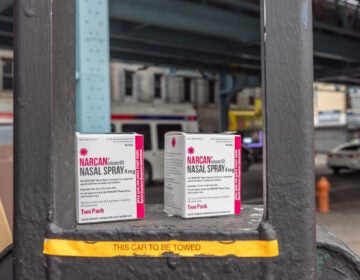Philly overdose deaths surged past 1,200 in 2017. The reason? Fentanyl
“Fentanyl has taken over from heroin as the number one drug that’s killing people in Philadelphia today,” said Health Commissioner Thomas Farley.

In this June 6, 2017 file photo, a reporter holds up an example of the amount of fentanyl that can be deadly after a news conference about deaths from fentanyl exposure, at DEA Headquarters in Arlington Va. (Jacquelyn Martin/AP Photo, File)
The number of people who died of drug overdoses in Philadelphia last year rose by more than one third to 1,217, the city announced Tuesday, making official the estimates health officials have been citing all year as they work to fight a worsening crisis of opioid overdoses.
According to the new report from Philadelphia’s Department of Public Health, opioids were involved in 88 percent of fatal overdoses in 2017.
The synthetic opioid fentanyl fueled last year’s surge, said Health Commissioner Thomas Farley.
“Fentanyl has taken over from heroin as the number one drug that’s killing people in Philadelphia today,” he said. “It is a particularly potent, particularly addictive, and particularly deadly opioid, and that has thrown gasoline on the fire of the crisis we were already seeing.”
The number of fentanyl-related deaths nearly doubled last year. Fentanyl or fentanyl-like “analogs” were involved in 846 fatal overdoses, nearly as many as the 907 total deaths caused by drug use in Philadelphia the year before.
The department also reported that more opioid deaths this year involved drug combinations that included cocaine or methamphetamine, continuing a trend that started in 2015.
Farley said the city is continuing to work to get doctors to prescribe fewer opioids, expand addiction treatment, and increase access to the overdose reversal drug naloxone. But he also said a supervised injection facility — or what the city is calling a comprehensive user engagement site — could play a role in preventing more deaths.
“These numbers certainly underscore that we have an absolute crisis here,” Farley said. “I’m hopeful this will build support for this one additional way we can use to save lives.”
According to a report prepared for the city by public health researchers, a single comprehensive user engagement site could save between 24 and 76 lives in one year.
The analysis of last year’s deaths found that all age groups and ethnicities were affected by the increase, but it reported the largest increases among Hispanics and found that slightly younger victims represented the greatest share of the overdoses. Overdose deaths among Hispanics shot up 60 percent, and victims aged 35 to 44 surpassed 45 to 54 year olds to become the age group suffering the most deaths.
There was one “glimmer of hope” in the report, Farley said. The death count decreased somewhat during the latter half of 2017. Farley speculated it could be a result of major drug busts or efforts to make naloxone more available, but added that he couldn’t officially explain the decrease.
“There are many things outside of our control, and so we’re going to have to continue to take as many steps as we can and hope those will cause the decline to continue,” Farley said.
WHYY is your source for fact-based, in-depth journalism and information. As a nonprofit organization, we rely on financial support from readers like you. Please give today.





